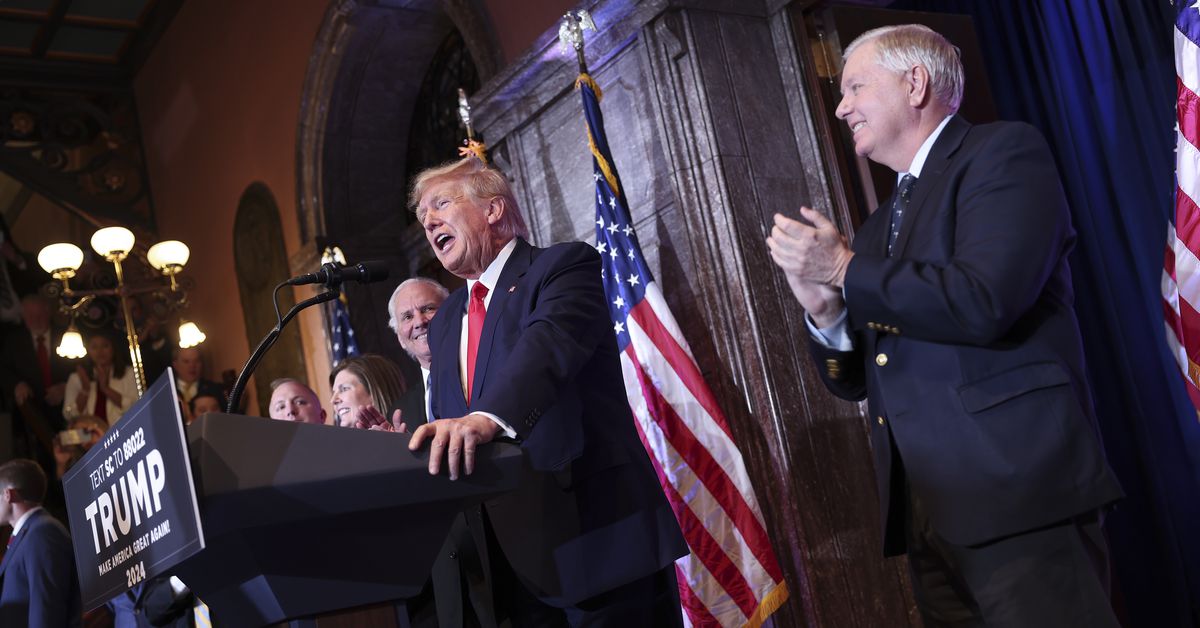
COLUMBIA, South Carolina — The South Carolina statehouse’s second floor is a study in profound historical contradictions. A full plaque engraved with the state’s resolution seceding from the Union in 1860 faces a portrait of Mary McLeod Bethune. A statue of John C. Calhoun stands feet away from where Nikki Haley announced that Tim Scott would be the first Black senator since Reconstruction and where she, years later, finally removed the Confederate flag from the state capitol grounds.
It’s also the place where Donald Trump tried to brand himself as both an incumbent and an insurgent while being neither.
In the first public event since he announced his 2024 presidential campaign, the former president struggled to achieve the synthesis of the anti-establishment impulses that helped him capture the presidency in 2016 or the air of total control and inevitability that led him to avoid any serious primary challenge in 2020 despite colossal midterm losses — and the first of what would be two impeachments.
Introducing Trump, first-term Rep. Russell Fry declared, “Never before in the history of the South Carolina primary has a presidential candidate received this much support this early in the day.”
More than a year before the primary, Trump unveiled the backing of the state’s governor, lieutenant governor, senior senator, and three of its six Republican members of Congress. It would be an astonishing lineup of endorsements for an insurgent candidate. When Trump was endorsed by then-Lt. Gov. Henry McMaster in 2016, that alone made national headlines. But Trump is no longer a political outsider: He is a former president. If he went to any state before his 2020 reelection bid where half of the congressional delegation didn’t show up, he would be viewed as weak.
The question is how to interpret just what the former president’s political strength is right now. No defeated former president has mounted a comeback bid since Grover Cleveland, who was controversial for his support for lower tariffs as opposed to, say, inspiring an attack on the US Capitol in an effort to overturn a presidential election. Other Republicans, of course, see Trump as vulnerable. It was pointed how he appeared in a space with such political significance to potential rivals like Nikki Haley or Tim Scott and while other potential rivals like Ron DeSantis sniff around.
Joe Wilson, a longtime Republican Congress member in the state, told Vox that Trump was “much stronger” than he was in 2016 when he faced his last competitive primary election in the Palmetto State. Wilson, who was supporting Trump, thought that the former president had “a real leg up” based on his record in the White House and cited what “he did for our country for jobs, for economic development, for national security, for the military, to the courts.”
The challenge is whether Trump can recapture the magic that helped propel his unprecedented 2016 presidential campaign this time around. His speech was a familiar mix of bellicose rhetoric off a teleprompter and an array of Trumpian riffs where he informed attendees about topics like the Taliban’s treatment of dogs and the fact that he, a millionaire real estate developer, is not much of a cook.
It also laid bare the contradictions facing his campaign. He started off with a denunciation of “RINOs” while standing next to Sen. Lindsey Graham, a comparative moderate in the modern Republican Party — the sort of Republican Trumps needs to win the nomination again. Graham was later heckled by the crowd because he did not accept Trump’s false claims about the 2020 elections. Trump went on to denounce electric cars next to McMaster, who has pushed for South Carolina’s automotive industry to become a center of EV manufacturing.
Earlier in the day, Trump spoke at the New Hampshire state GOP convention. There, the former president tried to reinforce his commitment to the race after not campaigning publicly for months, telling the crowd, “I’m more angry now and I’m more committed now than I ever was,” in the course of a Trump stemwinder of the type the former president often delivered in 2016.
The question is just how committed he will be in the course of the nearly two years remaining in the 2024 campaign. The former president is no longer the television personality who can lob bombs freely at all comers ranging from elected officials to Rosie O’Donnell based on his moods and the promise that his much-touted real estate expertise can solve all problems.
But he also isn’t the all-powerful president of the United States with all the resources that provides. Trump is caught in a middle ground without any measuring stick to gauge how he’s doing or precedent to put him in perspective. Instead, he has to navigate a maze of contradictions where it’s hard to tell just what Trump is or how he fits in — save, of course, the fact that no one is confusing him with Grover Cleveland.

